CE888 Assignment
Lungs CT-based Classification for COVID19 Vs Non COVID 19
-
Abstract
During the Pandemic of COVID 19, the diagnosing process was done by Computed Tomography CT) to COVID19 patients. Because of privacy problems, it was difficult to get the datasets of CT which was available publicly. Hence the research process and progress in AI powered method of diagnosis of COVID19 supported on CTs were hindered. In order to solve the issue UC San Diego and UC Berkeley have created an open-sourced dataset of COVID- CT that consist 349 CT images from 216 patients with COVID19 and 463 Non-COVID19. [1]. In this connection our task is to perform the binary image classification and to enhance the performance of the solutions that was provided in the table for COVID 19 patients by the use of proper metrics. The datasets can be taken from GitHub. Here we are using the technique of Deep Neural Networks. The goal of this project is to enhance the performance as well to beat the results provided from earlier experiments on CT images of COVID 19 patients. The results are taken for comparison with the existing results. In order to do this we have used the datasets from GitHub and the technique used is CNN to find the results in terms of accuracy, precision, Recall, F1 score and AUC.
-
Introduction
It is important to detect COVID19 disease in earlier stage and immediately the affected people have to be quarantined because of the insufficient or non-availability of special drug to COVID19. The people who are infected may spread this virus to the people who are in healthy because of communicable class of nCoV. It was being observed that, there was a bilateral change in the chest CT images of infected people. Hence, chest CT is employed as effective tool towards detecting the infection occurred by nCoV because of higher sensitivity [2] The national health commission of china has reported as the images of chest CT can be used to find out the infection occurred by nCoV. [3] Large amount of information about pathology could be getting through CT of chest. The radiologists are needed to assess the images of CT, so the need arises to establish the deep-learning supported protection methods for analyzing the chest CT with no intervening of radiologist. [4]. The main aim of this research is to enhance the performance as well to beat the results provided from earlier experiments on CT images of COVID 19 patients. The results are taken for comparison with the existing results. Our task is to perform the binary image classification using deep neural networks to improve the performance that was provided in the table for COVID 19 patients by the use of proper metrics and the datasets can be downloaded from GitHub.
- Background / Literature Review
Most of the researchers are perceived the patterns of imaging on chest CT to detect COVID19. [5] Also some of the researchers have studied about sensitivity of RT-PCR as well as chest CT at the time of detecting COVID19. They analyzed in –depth by using the history of travel as well as symptoms from two patients and determined that the chest CT sensitivity in detecting the COVID19 is very high than Reverse- transcription Polymerase Chain reaction- (RT-PCR). Chest CT is offering better sensitivity in detecting the COVID19 against RT-PCR. Relationship betwixt CT scan as well symptom is developed from the results. The techniques of DL are applied broadly in detecting the acuter pneumonia in the images of CT-chest. The model of CNN is employed for predicting the diseases and the accuracy attained from the model was about 86 %. [6] Gozes has established and AI-based analysis of CT for the detection as well as quantification. This system has developed the sensitivity of 92 % and the system is extracting the opacities in terms of slices at lungs by automatically. The proposed system is strong enough against thickness of slice and spacing of pixel. [7] Shang has established Dl supported system called VB-net towards automatic segmenting of lungs and the sites which was infected by utilizing the chest-CT.
COVID19 has affected more number of people around 1.3 million in entire world as well caused more number of deaths. [8]. One of the severe obstacles is controlling as well as spreading of disease due to the fact of inefficiency and insufficient medical diagnosis. The researchers are raising the efforts on establishing the DL methods towards diagnosing COVID19 supported on the scan images of CT. In this research the author has addressed two kinds of issues such as reproducing the results by adopting the datasets of CT which are not available publicly and this requires huge number of images in CT towards training the models in accurate. In this the author has proposed approach namely self-Trans that integrates the contrastive self-supervised learning and transfer to decrease the overfitting risk.
Chest-CT has possible role in diagnosing, detecting the complications as well as prognosticating of the disease COVID19. Establishing the proper safety and precautionary measures , optimization of protocol of chest-CT, systematic reporting scheme supported on the findings of pulmonary related to this disease would improve the utility service in clinics. However, the examinations of chest CT might lead to the results of false-negative and false-positive. In addition, the value added in diagnostic and decision taking on chest-CT is depends on various variables, resources, Personal protective equipment, scanners, availability of hospital as well as radiologist, RT-PCR tests, etc. [9] In this the author describes managing and imaging of patients care with protocol of chest CT, findings, complications, accuracy in diagnosing, reporting as well as communicating the findings on chest CT.
[10] Pedro et al, describes that, the early detection as well as diagnosis are considered as critical aspects in controlling the spread of COVID19. There are many DL supported techniques are proposed for diagnosing with the CT scan image. Though there are issues in diagnosing duet to the treating the entire CT scan as independent slice, methods of training and testing with dataset images. Various datasets will present the images of different quality that might come through the variety of CT scanner machines. This problem can be solved by efficient DL method for screening COVID19 with the approach of voting –based. In this system the images are classified as group in the system of voting. It is tested with two large COVID 19 dataset and analysis of CT with patient-based splitting. From the experimental results the author said that the detection of COVID19 with images of CT has to be improved remarkably to evaluate the methods in real-time scenario.
From the above review, it is observed that the images of chest-CT could be utilized for earlier classification of infected people by COVID19.
-
Methodology
Convolutional Neural Networks
This is considered as efficient tool that is used for classification of images. The structure and feature extraction features from the image creates CNN as active model for the classification. The layers are arranged in 3D such as width, height, as well as depth. The neurons present in the prescribed layer does not attach to the complete neuron set in the behind layer with restricted neurons. At last, the output decreases to the single vector score in probability in the depth side dimension. The frameworks for training as well as testing of deep Convolutional for the classification of COVID19 is given in figure 1. For the purpose of classifying COVID19 patients the features of chest –CT images are utilized to find accurately in patient classification that they are being infected or not infected. This process of detection based on the images chest CT from the classification of diseases that involves in the process of repeated calculations as well as computations. In order to classify the infected patients of COVID 19, CNN model will be utilized. The following steps are involved in this process.
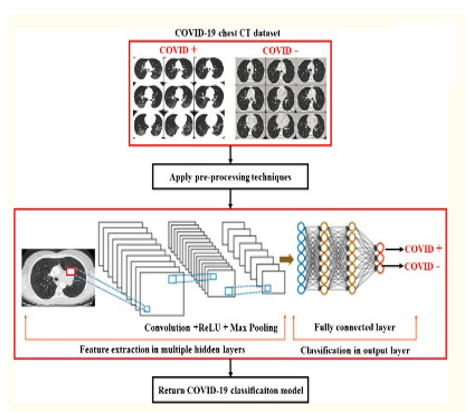
Figure 1: Block diagram of CNN-based COVID19 classification Model [4]
- Feature Extraction
Here, CNN is implementing various convolutions as well as pooling functions to assess and monitor the possible features. The layer of Max pooling is used to reducing spatial size of features that are convolved. It is having the ability to conquer the issue of overfitting. It observes the maximum areas from feature map which is obtained from the operator of convolution. [11] Next rectified Linear Unit (ReLU) activation function is employed towards learning the mappings betwixt inputs and the variable of responses. It is referred to the linear function which produces the results in directly in case it is positive, else the output will be zero.
- Classification
In this stage, the completely or fully connected layers will be acting as classifier. It uses the features that is extracted and evaluated the object probability in the images. Generally the function of activation and the layer of dropout are employed to develop the non-linearity and conquer the overfitting.
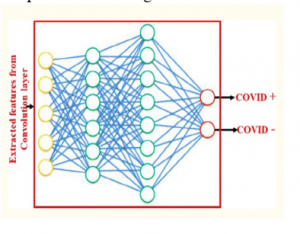
Figure 2: Fully connected layers. [4]
Dataset
The dataset is downloaded from GitHub. These are COVID CT images of dataset.
-
Results
Loading Dataset
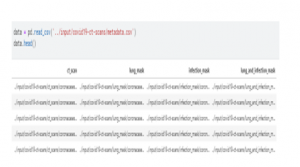
The dataset is COVID 19 CT Scan images. The figure shows the loading process of dataset in to the system.
Sample images
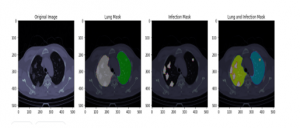
It shows the images of CT which is taken as samples. The first image is Original image, the second one is Lung mask, the third one is infection Mask, and fourth one is Lung sand Infection mask images of chest CT.
Splitting data

The dataset is splitted into two types such as training and testing. This is splitted for lungs – train and test ; Infections – train and test with test sizes as 0 , 1.
Building the model
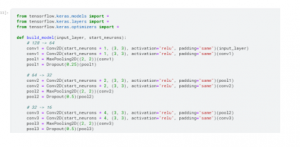
It shows the building the model, the tensor flow and Keras models are taken for the importing the data. The model is build using input layer and starting the neurons. It is created using Maxpooling, drop out, Relu etc.
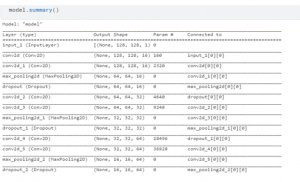
It shows the summary of the model in terms of; Type of layer, shape of the output, parameter and connected to functions.
Running 10 epochs
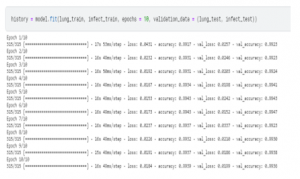
It shows the running of epochs. There are 10 number of epochs are utilized. The model is build with lungs – train; infect- train; epochs is 10. The validation of data is by lung-test and infect test, that means the testing the data of lungs and infect. The results are obtained with loss, accuracy, validation loss and accuracy for all the 10 epochs.
Accuracy of the model
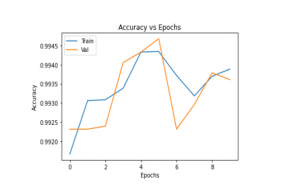
Figure 3 Accuracy Vs epochs
It shows the accuracy of the model with train and test data. The accuracy obtained will b e more than 95%.
Accuracy of train and validation dataset

Here the accuracy of the training and validation dataset is given for 10 epochs
-
Discussion
The results of COVID19 infected patients are already tabulated in the question. Now we will make comparison of the results
Table 1: results of the proposed model
| Metrics | Feature extraction / Transfer learning | Fine tuning Transfer Learning | CNN Model |
| Train accuracy | 0.88 | 0.99 | 0.99 |
| Validation accuracy | 0.74 | 0.91 | 0.99 |
| Test Accuracy | 0.84 | 0.88 | 0.96 |
| Precision | 0.94 | 0.97 | 0.99 |
| Recall | 0.72 | 0.79 | 0.86 |
| F1 Score | 0.82 | 0.87 | 0.89 |
| AUC | 0.84 | 0.88 | 0.90 |
From the results the table shows the values of proposed CNN model to diagnose the COVID patient with chest CT. Images. I have implemented the model of CNN to obtain the results. The obtained results beats the previous results in terms of prescribe metrics. The proposed model gave the results in better compared with previous one.
Quantitative analysis
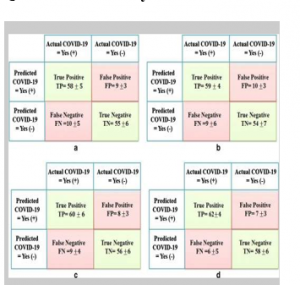
Figure 4 Confusion Matrix
The confusion matrix shows the classification of COVID19 diseases. It exhibits that the proposed design has lesser value of false-negative and false-positive. Hence we can conclude that the proposed model will be efficient to classify the patients of COVID19.
Receiver Operating characteristics (ROC) is defined as performance measuring curve for the classification in consideration with threshold values It is the curve of probability the separates the classes such as COVID 19(+) and COVID19 (-). It assess the performance of models and distinguishes the (+) and (-). In case the ROC his higher then classification will be better.
Accuracy is calculated by the process of dividing the classified class by total classes. It is a primary measuring towards computing the classification performance. It is obtained as 99%.
F1 Score – It is the famous measure that provides remarkable details of classification particular when the data has the classes as imbalanced. It computes the weighted harmonic average in terms of precision and recall. These values are also higher than other results.
Sensitivity calculates the COVID19 ( +) patients only in terms of performance. It identifies the patients who are all originally infected by the disease COVID 19.
-
Conclusion
In this research, the COVID19 classification using CNN model is used to classify the infected people from the images of chest CT. At starting, the test data is splitted into training and testing. The training dataset was employed to build the COVID19 model classification. Overfitting is avoided by the process of pre-preprocessing. The data set is subjected to experiments using CNN model classification, and the results obtained are better to beats up the previous results of COVID19 patients. This proposed method gives the results in terms of accuracy, precision, recall are tabulated and compared with previous one. The proposed system produced the results of 99 % accuracy in training, validation, and testing as 99 %, 99% and 96 % respectively. Thus we have completed the classification models of Lungs CT-based COVID19 Vs Non- COVID19 using chest CT images
Future work can be done with larger CT image datasets towards trying to cover huge spectrum of sensors, ethnic groups as well process of acquisition for validation.
References
| [1] | Y. Z. X. H. a. P. X. J. Zhao, “COVID-CT-dataset: a CT scan dataset about COVID-19,” arXiv, p. preprint arXiv:2003.13865, 2020. |
| [2] | J. X. M. C. D. P. L. X. L. S. Y. L. C. Y. S. J. L. G. L. Y. Z. H. X. K. R. L. W. W. Xu X, “eep learning system to screen coronavirus disease 2019 pneumonia,” arXiv, vol. preprintarXiv:2002.09334, pp. 1-29, 2020. |
| [3] | Worldometer, “Coronavirus.,” https://www.worldmeters.info/coronavirus/countries-where-coronavirus-has-spread/., 2020. |
| [4] | V. K. V. a. M. K. Dilbag Singh, “Classification of COVID-19 patients from chest CT images using multi-objective differential evolution–based convolutional neural networks,” Eur J. Clin.Microbiol Infect Dis., pp. 1-11, 2020. |
| [5] | B. A. M. X. e. a. Chung M, ” CT imaging features of 2019 novel coronavirus (2019-nCoV),” Radiology, vol. 295, no. 1, pp. 202-207, 2020. |
| [6] | G. O. e. al, “Rapid AI development cycle for the coronavirus (COVID-19) pandemic: initial results for automated Detection & patient monitoring using deep learning CT image analysis.,” arXiv , p. preprint arXiv:2003.05037, 2020. |
| [7] | G. Y. W. J. S. W. S. N. H. M. X. Z. S. Y. Shan F, “Lung infection quantification of COVID-19 in CT images with deep learning,” arXiv, vol. preprint arXiv:2003.04655, pp. 1-19, 2020. |
| [8] | X. Y. S. Z. J. Z. Y. Z. E. X. P. X. Xuehai He, “Sample-Efficient Deep Learning for COVID-19 Diagnosis Based on CT Scans,” medRxiv, p. doi: https://doi.org/10.1101/2020.04.13.20063941, 2020. |
| [9] | R. M. K. Thomas C. Kwee, “Chest CT in COVID-19: What the Radiologist Needs to Know,” RadioGraphics, vol. 40, no. 7, pp. 1848- 1865, 2021. |
| [10] | E. L. G. S. G. M. R. S. D. L. D. M. Pedro Silva, “COVID-19 detection in CT images with deep learning: A voting-based scheme and cross-datasets analysis,” Elsevier , vol. 20, pp. 1-10, 2020. |
| [11] | S. I. H. G. Krizhevsky A, “Imagenet classification with deep convolutional neural networks;,” Advances in neural information processing systems. , pp. 1097-1105, 2012. |
Know more about UniqueSubmission’s other writing services:


Thanks-a-mundo for the blog.Really looking forward to read more. Cool.
https://siambookmark.com/story16884179/examine-this-report-on-flange-manufacturer-in-kolkata
Great post. Really Great.
https://archeriwkw87543.spintheblog.com/25727230/navigating-the-maze-a-guide-to-work-permits-in-europe
Muchos Gracias for your blog.Really thank you!
https://seolistlinks.com/story18056601/the-fact-about-pvc-industrial-floor-tiles-that-no-one-is-suggesting
I truly appreciate this blog post.Really thank you! Great.
https://nsfws.ai/
I really like and appreciate your post.Thanks Again. Keep writing.
https://nsfws.ai/
I really like and appreciate your article.Thanks Again. Keep writing.
https://www.laifentech.com/
I truly appreciate this article.Thanks Again. Really Great.
https://www.orangenews.hk
Appreciate you sharing, great blog post.Really looking forward to read more. Great.
https://inspro2.com/
Thanks-a-mundo for the blog post.Really looking forward to read more. Keep writing.
https://talkietalkie.ai/
wow, awesome blog post.Thanks Again. Much obliged.
https://meencantalapinturadediamantes.es/
Thank you for your article.Really thank you! Want more.
https://nsfw-ai.chat/
Very neat blog.Really thank you! Keep writing.
https://nsfw-ai.chat/
Enjoyed every bit of your article. Want more.
https://nsfws.ai/
Thank you for your blog.Much thanks again. Awesome.
https://summerseasiren.com/collections/period-underwear
Enjoyed every bit of your post.Much thanks again. Great.
https://alexisdrfs65421.salesmanwiki.com/8653302/revolutionize_your_99_114_121_112_116_111_trading_with_the_best_ai_99_114_121_112_116_111_trading_bots
Really informative post.Much thanks again. Want more.
https://zaneyodp64320.wikibriefing.com/2413312/revolutionize_your_99_114_121_112_116_111_trading_with_the_best_copy_trading_bots
Really enjoyed this blog post.Really looking forward to read more. Want more.
https://hi8802334.blogrelation.com/31545121/the-best-side-of-amul-toned-milk-in-raj-nagar-extension-price
Thanks so much for the blog.Really thank you! Want more.
https://https-hi881-com45166.blue-blogs.com/31198415/keeping-your-cool-the-ultimate-guide-to-ac-repair-services
A big thank you for your blog post.Really looking forward to read more. Fantastic.
https://tysondmtx33580.wikilinksnews.com/5154389/the_advantage_using_best_payroll_software
Hey, thanks for the post.Really looking forward to read more. Cool.
https://jaidenqese20986.celticwiki.com/541072/the_advantage_of_online_nift_coaching
I appreciate you sharing this post.
https://saxenda-kopen30896.webbuzzfeed.com/26168579/unlock-your-career-with-iosh-managing-safely-training-in-india
Im thankful for the post.Really thank you! Keep writing.
https://troyqkbq76432.wikiadvocate.com/5860337/what_is_osha_courses_online
A round of applause for your blog post. Want more.
https://arenaplus.ph/
Major thankies for the blog article.Much thanks again.
https://www.sonhungbac.com/
Thanks-a-mundo for the article post.Much thanks again. Keep writing.
https://baixicans.com/
Thanks-a-mundo for the blog article.Really looking forward to read more. Really Great.
https://atop-education.degree/
Great article post.Thanks Again.
https://gbdownload.cc/
I cannot thank you enough for the article post.Really thank you! Want more.
https://fouadmods.net/
I really like and appreciate your article post.Really looking forward to read more. Will read on…
https://gbdownload.cc/
I truly appreciate this article. Want more.
https://fouadmods.net/
Thanks-a-mundo for the article post.Really looking forward to read more. Great.
https://nsfwgenerator.ai/
This is one awesome article post.Really looking forward to read more. Much obliged.
http://animegenerator.ai/
Say, you got a nice blog post.Thanks Again. Really Cool.
https://mbti70215.thezenweb.com/explore-the-enchanting-beauty-of-karnataka-top-tourist-destinations-you-can-t-miss-62604466
I am so grateful for your article.Thanks Again. Fantastic.
https://edmundt950eys6.bloggactivo.com/profile
Appreciate you sharing, great blog article. Awesome.
https://mbti94838.tusblogos.com/25047717/unveiling-the-power-of-ecwid-a-comprehensive-review
Im obliged for the blog.Really thank you! Really Great.
https://josueuiwi31098.onzeblog.com/25294163/the-advantage-of-satta-matka-game
Thanks a lot for the blog.Really thank you!
https://kylerymzl43109.blogunok.com/25493021/the-advantage-of-satta-matka-game
Awesome blog article.Thanks Again. Really Cool.
https://spencernalx86531.59bloggers.com/25629782/tips-to-find-spa-and-beauty-services
Very neat article.Thanks Again. Really Cool.
https://andyynbn54310.slypage.com/25660328/tips-to-find-spa-and-beauty-services
Thanks a lot for the article post.Really looking forward to read more. Awesome.
https://damienpcoa98753.tblogz.com/tips-to-find-spa-and-beauty-services-39540217
Im thankful for the blog post. Cool.
https://hi-8876156.bloggip.com/25134634/elevate-your-style-buy-bracelets-for-men-online-at-vavdiya-com
Very informative article post.Much thanks again. Really Cool.
https://muscle-cars89032.blogscribble.com/25781357/unravel-the-majesty-of-the-himalayas-with-goechala-trek-itinerary-booking-and-pricing
Really enjoyed this blog.Really thank you! Much obliged.
https://www.hommar.com/video/products-detail-4553773
I value the article post.Much thanks again. Much obliged.
https://www.hkcashwebsite.com
Thank you ever so for you article post.Really thank you! Much obliged.
https://www.hommar.com/ja/video/products-detail-4544990
Fantastic blog post.Really looking forward to read more. Fantastic.
https://www.kol.kim/custom-design/
This is one awesome blog post.Really thank you! Will read on…
https://blog.huddles.app
Wow, great article post.Much thanks again.
https://crushon.ai/
Fantastic article post.Really looking forward to read more. Want more.
https://crushon.ai/
Hey, thanks for the blog.Really thank you! Awesome.
https://www.hommar.com/products-44915
Awesome post. Awesome.
https://crushon.ai/
Thanks a lot for the article.Thanks Again. Really Great.
https://crushon.ai/
Im thankful for the post.Thanks Again. Cool.
https://keeperaitest.com/
Really enjoyed this article.Really thank you! Want more.
https://crushon.ai/character/7573a4cc-a7fc-4c3b-9b11-0f296d2bde95/details?not-for-all-audiences=true&utm_medium=home
Fantastic post. Fantastic.
https://ai-sexting.top/
Major thankies for the blog post.Really looking forward to read more. Want more.
https://spicychat-ai.online/
I really like and appreciate your article post.Thanks Again. Great.
https://crushon.ai/
Thanks a lot for the article.Really looking forward to read more.
https://crushon.ai/
I really enjoy the post.Really thank you! Really Cool.
https://crushon.ai/
I really enjoy the article post.Really looking forward to read more. Much obliged.
https://crushon.ai/
Hey, thanks for the blog post.Much thanks again. Really Great.
https://www.kol.kim/custom-design/
I really like and appreciate your blog post. Keep writing.
https://www.yinraohair.com/wigs/shop-by-style/bob-wigs
Appreciate you sharing, great blog article.Really thank you! Awesome.
https://www.yinraohair.com/human-hair/clip-ins
Very informative article.Thanks Again. Want more.
https://www.yinraohair.com/cosplay/shop-by-color/blonde
I truly appreciate this post.Much thanks again. Will read on…
https://www.metalfenceworks.com/e_productshow/?63-Metal-Barriers-Crowd-Control-Safety-Barricade-63.html
I think this is a real great blog.Thanks Again. Awesome.
https://blog.huddles.app
Great, thanks for sharing this blog.Really looking forward to read more. Will read on…
https://umhom13.com
Thanks a lot for the blog post.Thanks Again. Great.
https://umhom13.com
Appreciate you sharing, great article post.Really looking forward to read more.
https://nsfwcharacters.ai/
I am so grateful for your blog article.Thanks Again. Really Great.
https://honorcase.com/
Say, you got a nice article.Really looking forward to read more. Want more.
https://www.hkcashwebsite.com
Im grateful for the article post.Really thank you! Will read on…
https://aura-circle.com/collections/aura-sleep-mask-collection
Awesome blog post.Really thank you! Keep writing.
https://x.yupoo.com/photos/lireplica/categories/2943206
Thanks for sharing, this is a fantastic blog post.Really thank you! Cool.
https://telagrnm.org
Very informative blog article.Really thank you!
https://telcgrnm.org/
Really appreciate you sharing this blog.Thanks Again. Awesome.
https://cncmachining-custom.com
Thanks-a-mundo for the blog post.Thanks Again. Want more.
https://www.topbet.game/?ch=110019
Fantastic blog post.Really looking forward to read more.
https://www.sunany.com/
Really appreciate you sharing this blog post.Really thank you!
https://www.haijiao.cn
Really informative blog post.Much thanks again. Want more.
https://www.haijiao.cn
Really enjoyed this post.Thanks Again. Great.
https://www.slsmachinery.com
Thanks a lot for the article. Fantastic.
https://www.wetwipes-manufacturer.com
Im thankful for the blog article.
https://www.jingpailianghao.com/
I cannot thank you enough for the post.Much thanks again.
https://crushon.ai/
Muchos Gracias for your blog article.Thanks Again. Really Cool.
https://crushon.ai/
This is one awesome post. Keep writing.
https://crushon.ai/
Really informative article post.Thanks Again. Much obliged.
https://crushon.ai/
Major thanks for the article.Really looking forward to read more. Awesome.
https://crushon.ai/
I am so grateful for your blog. Want more.
https://crushon.ai/
Thanks again for the article.Thanks Again. Really Cool.
https://crushon.ai/character/f5757531-9a53-4c38-85ef-cd5ae51cdc13/details
Im obliged for the blog post.Really thank you! Really Great.
https://crushon.ai/character/0370eef1-b4fb-4c24-b4e5-8f66b79d401d/details
Thanks again for the post.Much thanks again. Fantastic.
https://crushon.ai/character/b2e7751b-b890-4697-ab6b-09b273d08cc2/details
Thanks for the article.Much thanks again. Great.
https://crushon.ai/character/c3d29626-272b-4b21-9b64-eaf5d98cf03b/chat
Thanks for the article post. Really Great.
https://smashorpass.app/
A round of applause for your blog post.Really looking forward to read more. Really Cool.
https://smashorpass.app/
Thanks for the blog article. Really Cool.
http://ai-gf.top/
Very neat blog post.Really looking forward to read more. Want more.
https://spicychat-ai.online/
Very informative article post. Fantastic.
https://janitorai.chat/
Appreciate you sharing, great blog.Really thank you! Will read on…
https://kobold-ai.com/
Hey, thanks for the blog.Really thank you! Want more.
https://commiss.io/webslotgacor/
Looking forward to reading more. Great blog article.Thanks Again. Awesome.
https://www.pyproxy.com
Hey, thanks for the blog post. Fantastic.
https://www.peryagame.ph
Great, thanks for sharing this blog article.Much thanks again. Cool.
https://vapzvape.com/
Thanks for sharing, this is a fantastic blog article.Much thanks again. Really Great.
https://vapzvape.com/
I loved your article post. Really Cool.
https://www.vibratorfactory.com
Major thanks for the post.Thanks Again. Will read on…
https://www.vibratorfactory.com
Thanks so much for the blog.Really looking forward to read more. Much obliged.
https://inspro2.com/
Hey, thanks for the article.Really thank you! Much obliged.
https://honista.io/
Im grateful for the article post.Much thanks again. Cool.
https://honista.io/